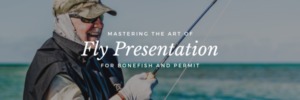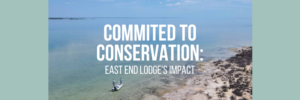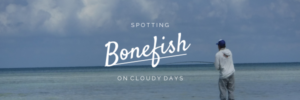Dark skies and strong winds don’t have to signal the end of your bonefishing trip. In fact, if you’re lucky, less than ideal conditions could mean having your best bonefishing day ever. While those who are easily daunted often hang back at the lodge, intrepid anglers have the opportunity to fully capitalize on the knowledge of their guides. More importantly, they’ll also discover that gloomy weather has a tendency to bring big bones right up close. Read on to find out how to make the most of dreary conditions.
Focus on Your Short Cast
Cloudy days frequently create a fierce glare on the water’s surface that makes it difficult to see anything, much less the elusive movements of bonefish themselves. When cloudy conditions are paired with high winds, you’ll find it all but impossible to spot bones tailing any significant distance away. Thus, these easiest and most likely place to spot bonefish at times like these is right near your boat. When the sky is overcast and the weather is windy, your short game means everything.
Get ready to deliver quick, short, and accurate casts with flawless presentation. You want to sink your fly without causing too much disturbance. If you have time before your trip, practice short-distance casting into the wind to perfect your technique. Short casts require approximately seven to nine feet of line outside of the rod tip, and a short stroke that only moves the tip of the rod between one and three feet. Load plenty of power when casting, but keep your movement short. There’s no room for false casts in less than ideal conditions.
Find Shelter From the Wind
No matter how much you practice casting in windy conditions, strong winds are guaranteed to be a challenge. Technique should always be paired with smart locations. Among some of the best places to get shelter from the wind are higher ground on the leeward side and in the mangroves. Your guide will bring you to the ideal places for both spotting big bones and mitigating the unruly weather.
Fish the Falling Tide
Make the tide work for you by paying attention to the patterns and behaviors of bonefish, and then catching their attention while they’re on the move. For instance, at high tide, bones have a tendency to search for food in the mangroves. You’ll probably see them tailing among the roots. However, when the tide falls, they have to make their exit. They often do so via the tiny channels that drain the water out of the mangroves as the tide falls. Paying careful attention to these highways and making quick, accurate casts is a great way to pick a few of these fish up.
Listen to Your Guide
Even if you’ve done plenty of bonefishing before, dramatic changes in weather conditions make the input of your guide absolutely essential. Although you might know the best way to catch bonefish on clear, sunny, and virtually windless days, your guide will know all of the habits and hiding places of bones when the weather turns ugly. If you have a long-term interest in this sport, less than ideal bonefishing conditions are an excellent opportunity to round out your skills, improve your speed, and learn more about this stealthy and incredibly intelligent species. However, this is only true if you pay attention to the advice that your guide is offering.
Be Extra Quiet
Given that you’ll likely spot bonefish right up close, you want to avoid spooking them. Be conscious about everything that lies on the boat bottom. Try not to trip or stumble over items, and avoid dropping anything heavy. Keeping the interior of the boat clean and well-organized is the best way to prevent unnecessary noise. You should also keep your voice lowered and take slow, measured, and light steps.
When casting to bones that are near the boat, your scent and clothing matter too. If conditions are less than ideal, dress to blend in with your surroundings. Wear a white or light blue shirt, and khaki, gray, or cream-colored trousers. Subtle, neutral tones will keep you concealed.
Avoid heavily scented self-care products such as aftershave as well, and choose fragrance-free deodorant and sunblock. If you have the chance to do so, take a small amount of dirt from the shoreline and use it to scrub any trace scents off of your hands. Remember, bonefish are smart and good at evading predators. If they catch your scent, spy a brightly colored shirt, or hear your footfalls on the boat bottom, they may get spooked and flee the area.








